As the initial market response to its new 5G system-on-chip (SoC) solutions appears to be positive, 5G represents an opportunity for MediaTek Inc (聯發科) to increase the average selling prices (ASPs) of its products and boost its earnings, analysts said.
Moreover, MediaTek is likely to see its 5G SoC solutions gain better traction among Chinese smartphone original equipment manufacturers (OEMs) beginning next year, they said.
“MediaTek’s 5G SoC development is on schedule and should pave the way for its smooth transition into the 5G era in 2020 and let it capture demand tied to the coming 5G-driven handset replacement cycle,” SinoPac Securities Investment Service Corp (永豐投顧) said in a research note released on Monday.
“The de-Americanization of Chinese vendors’ supply chains would also help boost its handset SoC shipments and stabilize its market share,” SinoPac said.
MediaTek is planning to mass-produce its first 5G SOC product in March next year, making it one of the world’s leading suppliers of 5G chips.
MediaTek’s shipments of 5G chips are likely to reach 30 million units next year and grow to 75 million units in 2021, Credit Suisse Group AG said in a report on Tuesday.
China’s Oppo Mobile Telecommunications Corp (歐珀), Vivo Communication Technology Co (維沃) and Xiaomi Corp (小米) are likely to become MediaTek’s major clients for 5G chips next year, while Huawei Technologies Co (華為) and Samsung Electronics Co might increase their orders in 2021, Credit Suisse said.
While 5G opportunities look good from next year onward, aggressive 5G pricing from Qualcomm Inc or a slower 5G adoption rate in China due to trade disputes with the US might pose potential risks for MediaTek, analysts said.
The company on Wednesday reported that its revenue increased 1.95 percent month-on-month and 1.69 percent year-on-year to NT$23.49 billion (US$761.43 million) last month, the most in 13 months.
Last month’s revenue growth helped lift the company’s third-quarter revenue to NT$67.22 billion, which was in line with the revenue forecast of NT$65.3 billion to NT$70.2 billion that MediaTek made in July.
In the first three quarters of the year, total revenue reached NT$181.51 billion, an increase of 2.45 percent compared with NT$177.17 billion in the same period last year.
So far this year, MediaTek’s sales were evenly distributed amid the company’s three major business segments — mobile computing; growth solutions, including Internet of Things and power management IC; and mature solutions such as television SoC — and all three segments’ ASPs and gross margins expanded from a year earlier, SinoPac said.
SinoPac gave MediaTek a long-term “buy” rating with a target stock price of NT$490, which was set based on a price-to-earnings ratio of 25, compared with its previous target price of NT$366 based on a price-to-earnings ratio of 22.
Credit Suisse maintained its “outperform” rating on the stock, but raised its target price on MediaTek from NT$365 to NT$440, and forecast earnings per share of NT$19.71 for next year.
MediaTek shares closed at NT$372 on Wednesday in Taipei trading. The stock has risen 62.09 percent since the beginning of this year, outperforming the broader market’s 11.95 percent increase over the period.

‘SWASTICAR’: Tesla CEO Elon Musk’s close association with Donald Trump has prompted opponents to brand him a ‘Nazi’ and resulted in a dramatic drop in sales Demonstrators descended on Tesla Inc dealerships across the US, and in Europe and Canada on Saturday to protest company chief Elon Musk, who has amassed extraordinary power as a top adviser to US President Donald Trump. Waving signs with messages such as “Musk is stealing our money” and “Reclaim our country,” the protests largely took place peacefully following fiery episodes of vandalism on Tesla vehicles, dealerships and other facilities in recent weeks that US officials have denounced as terrorism. Hundreds rallied on Saturday outside the Tesla dealership in Manhattan. Some blasted Musk, the world’s richest man, while others demanded the shuttering of his

ADVERSARIES: The new list includes 11 entities in China and one in Taiwan, which is a local branch of Chinese cloud computing firm Inspur Group The US added dozens of entities to a trade blacklist on Tuesday, the US Department of Commerce said, in part to disrupt Beijing’s artificial intelligence (AI) and advanced computing capabilities. The action affects 80 entities from countries including China, the United Arab Emirates and Iran, with the commerce department citing their “activities contrary to US national security and foreign policy.” Those added to the “entity list” are restricted from obtaining US items and technologies without government authorization. “We will not allow adversaries to exploit American technology to bolster their own militaries and threaten American lives,” US Secretary of Commerce Howard Lutnick said. The entities

Minister of Finance Chuang Tsui-yun (莊翠雲) yesterday told lawmakers that she “would not speculate,” but a “response plan” has been prepared in case Taiwan is targeted by US President Donald Trump’s reciprocal tariffs, which are to be announced on Wednesday next week. The Trump administration, including US Secretary of the Treasury Scott Bessent, has said that much of the proposed reciprocal tariffs would focus on the 15 countries that have the highest trade surpluses with the US. Bessent has referred to those countries as the “dirty 15,” but has not named them. Last year, Taiwan’s US$73.9 billion trade surplus with the US

Prices of gasoline and diesel products at domestic gas stations are to fall NT$0.2 and NT$0.1 per liter respectively this week, even though international crude oil prices rose last week, CPC Corp, Taiwan (台灣中油) and Formosa Petrochemical Corp (台塑石化) said yesterday. International crude oil prices continued rising last week, as the US Energy Information Administration reported a larger-than-expected drop in US commercial crude oil inventories, CPC said in a statement. Based on the company’s floating oil price formula, the cost of crude oil rose 2.38 percent last week from a week earlier, it said. News that US President Donald Trump plans a “secondary